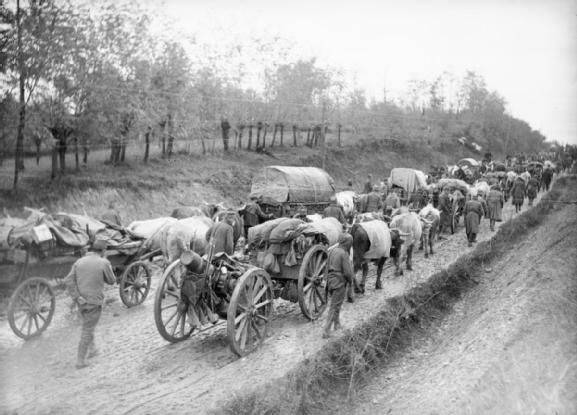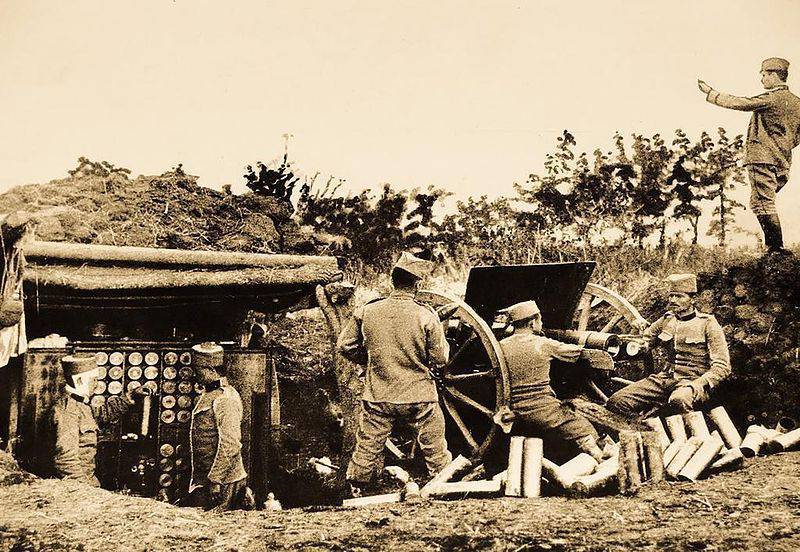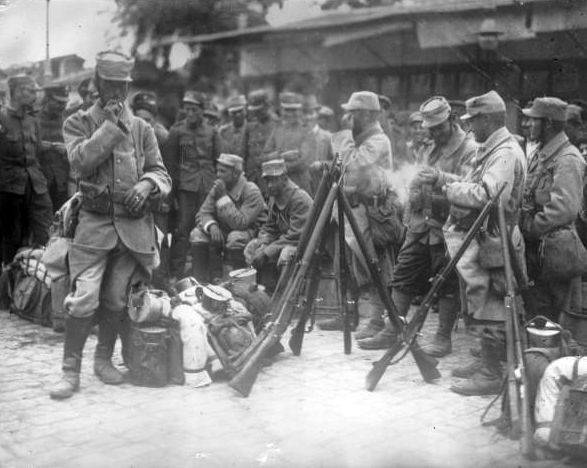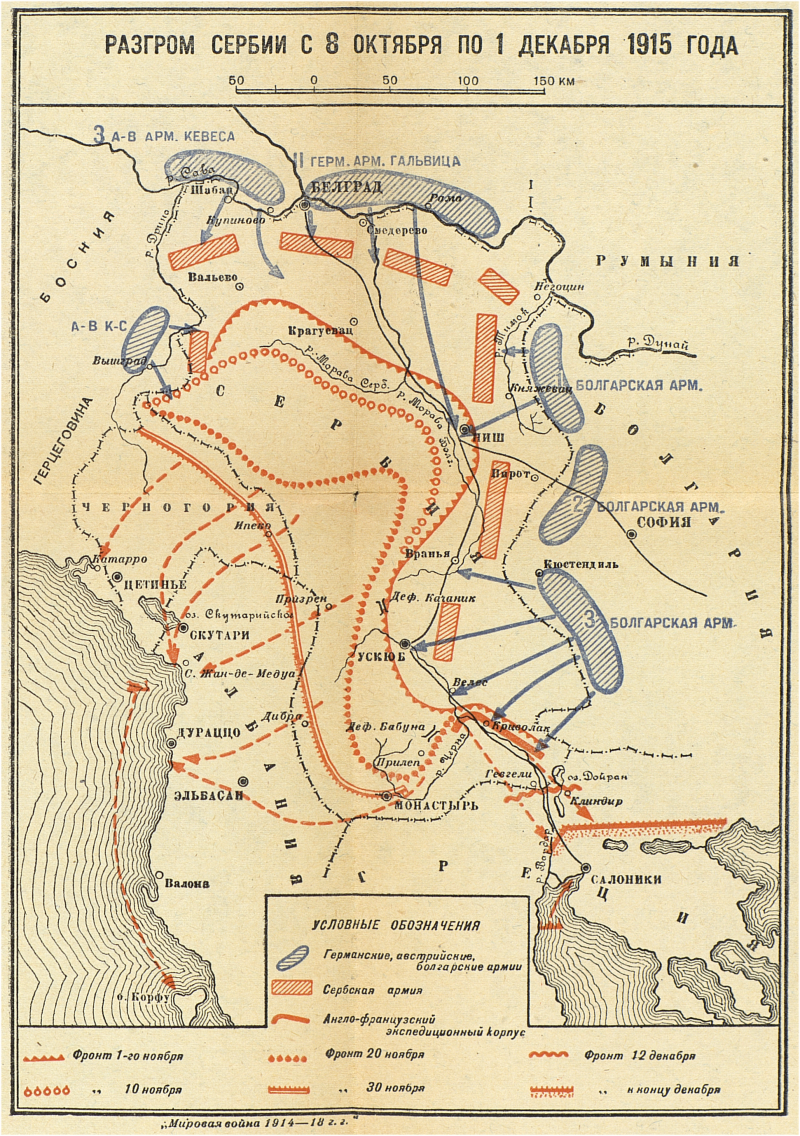How to defeat Serbia

At the beginning of the 1915 of the year, there was a lull in the Balkan front. The defeat of the Austro-Hungarian Empire in the 1914 campaign of the year dealt a serious blow to the plans of Austria and Germany, which could not bring Serbia out of the war and establish a direct connection with Turkey. The Austrians and Serbs were preparing for new battles. The Serbian army, despite its success, suffered heavy losses and needed to be restored. Serbia was sorely lacking weapons, ammunition, epidemic (typhoid) raged, people were starving. The country was in a difficult situation and needed external help.
By the summer of 1915, Belgrade is able to restore the combat capability of its army. A great role in this was played by the help of the allies - France, Britain and the Russian Empire. During the breakthrough of the Russian front and the Great Retreat of the Russian army from Galicia and Poland, the Russian command appealed to Belgrade with the request to organize a diverting offensive in order to delay part of the Austro-Hungarian troops. However, the commander of the Serbian army Radomir Putnik replied that the Serbian army did not have sufficient forces and means to attack.
In the 1915 year, the Central Powers finally decided to crush Serbia and Montenegro in the 1915 year in order to establish contact with the Ottoman Empire. At the same time, it was obvious that Austria itself, without the support of Germany, would not be able to crush Serbia. On the Serbian front, positional calm persisted and the troops did not conduct any operations. Germany and Austria-Hungary were preparing a major offensive operation and tried to win over Bulgaria. In addition, in the summer and early autumn of 1915, the Austro-German troops launched a major offensive on the Russian front and could not divert large forces to Serbia. In the autumn, neither from the Russians, nor the French, nor with the British in Germany, large-scale operations were expected and a “window” appeared for the defeat of Serbia.
6 September 1915 was a military convention between Bulgaria and the Central Powers in Sofia. The performance of Bulgaria on the side of Germany led to the fact that the Central Powers formed a solid theater from the North Sea to Baghdad, giving them the opportunity to use the great natural resources of the Ottoman Empire. The last small obstacle was only Serbia. The Serbian army needed to be destroyed in order to establish firm control over the Balkans and to prevent the Entente powers from changing the situation on the peninsula in their favor. And such an opportunity would have been if England and France had transferred a large army to support Serbia, which inevitably led to the performance of Greece on the side of the Entente. However, Britain and France ineptly used troops and resources in the failed and protracted Dardanelles operation, and they did not have enough time to render effective assistance to Serbia and Montenegro. This situation led Germany, which at that time was distracted by the battles on the French front (Third Battle of Artois), to organize a large-scale operation to completely destroy the Serbian army and, to ensure the success of the operation, to send German divisions there.
Preparation of the operation
The German command estimated the enemy's forces at about 200 thousand people. In order to defeat the Serbian army, Germany and its allies decided to insert about 330 thousand people. The German units were reinforced by heavy artillery and mortars.
The position of the Central Powers vis-à-vis Serbia allowed for wide-ranging operations from Bosnia, Hungary and Bulgaria. However, a number of objective circumstances interfered with this. Thus, the Austro-Hungarian troops stationed in Bosnia and Herzegovina were weakened by the allocation of units to the Italian front, to the area of r. Isonzo, therefore, did not have sufficient shock power to conduct an offensive deep into Serbia. As a result, the Austrian troops in the Bosnian direction were content with an auxiliary role and had to tie down the army of Montenegro.
Germany, on the other hand, could not quickly strengthen the Austro-Hungarian army in the Bosnian sector with its troops, as the communication lines on the Serbian-Bosnian border were in poor condition and it was impossible to improve them in a short time. As a result, and also in order not to repeat Potiorek's mistakes on r. Drin in 1914, when the Austro-Hungarian troops had to attack in difficult terrain with large water obstacles and mountain ranges, the German command refused to strike on the western front of Serbia. It was decided to limit the simultaneous strikes against the northern and eastern fronts of Serbia. This offensive made it possible to hope for success, since the Central Powers had superior forces on each of the two fronts. According to the calculations of the head of the German General Staff Falkenhain, the Serbs could not use the benefits of actions on internal operational lines, quickly moving troops from one direction to another, because the communications of Serbia were poorly developed. In addition, the Serbs were distracted by the Bulgarian army, which was supposed to cut off the main railway communication Belgrade - Thessaloniki, which connected Serbia with the outside world.
Forces of the Central Powers
According to the plan of the Austro-German leadership, strikes from the north-east and north, as well as Bulgarian strikes from the east in the direction of Kragujevac and Niš were to surround and destroy the Serbian army in the center of the country. In total, the Central Powers concentrated the 14 of the Austro-German and 6 Bulgarian divisions under the overall command of Field Marshal August von Mackensen, who was noted on the Russian front as the organizer of the Gorlitsky breakthrough. Total Austro-German troops numbered about 330 thousand people.
On the right flank of the Austro-German army against Montenegro, the 19 Austrian corps was located. On r. Sava and at its confluence in r. The Danube (on the so-called Sava front) was the 3-I of the Austro-German army of General German Köwess, consisting of three Austro-Hungarian infantry divisions, and the German corps - four divisions. The Austro-Hungarian command could not deploy the number of divisions (six divisions) specified in the treaty with the kingdom of Bulgaria, as the situation in Volyn and Galicia was disturbing. Austria-Hungary feared a Russian offensive. Therefore, additional troops had to put the German Empire. 3-i Army Köwess was to force the river. Sava with the main forces in the Belgrade direction and deliver an auxiliary blow to Kupinov and then, securing himself from the r. Kolubary, advancing through the Topol towards Kragujevac. The army was well equipped for action in the highlands.
On the river. Danube, east of the mouth of the river. Temeni, was located the new 11-I German army of General Max von Galvitsa consisting of seven infantry divisions, reinforced by heavy artillery. The main forces of this army had to go p. The Danube is at Rama, and the auxiliary - at Semendria (Smederevo). After the transition 11-th army through the river. Danube, she had to advance up the river. Morava, on Niš, where the Germans planned to connect with the Bulgarians.
Bulgaria mobilized 500-th. the army. At the same time Bulgaria could put 12 first divisions for 20 thousand fighters in each (in the division - 18 battalions and from 36 to 72 guns) with modern weapons. In addition, there was a reserve army, people's militia and spare troops, to replenish the losses of the current army. The artillery of the Bulgarian gunners consisted of French and German cannon and howitzers systems Schneider and Krupp. In the 1915, the Bulgarian army had 428 75-mm field guns, 103 75-mm mountain guns and 34 120-mm howitzer, about Maxim 250 machine guns. Also at the time of entry into the First World War in Bulgaria, there were 2 aeronautic units armed with 5 airplanes. At the end of September, 1915 arrived in Bulgaria 3 Germanic aircraft to protect Sofia. It must be said that, despite the defeat in the Second Balkan War, the Bulgarian army was the best army in the Balkan countries. The leadership of the country and the military command paid great attention to the army, the introduction of new products. At a high level, combat training was set, officers and non-commissioned officers were trained taking into account the experience of past wars. The officers were trained at the Sofia Military School, and many officers of the Bulgarian army had foreign military education, mainly obtained in the Russian Empire. At the end of 1913, Bulgaria increased its purchases of weapons and ammunition in Austria-Hungary and Germany. The downside was the fact that Bulgaria did not have a developed military industry, which made the country dependent on arms supplies from abroad.
The Bulgarian command deployed two armies for action against Serbia: 1) 1 Army General Boyadjiev - 4 Infantry Divisions (1, 5, 6 and 8); 2) General Todorov's 2 Army (7 Division, Macedonian Chetnik Legion and one cavalry division). The right flank of the 1 Army ensured communications in the Danube Valley, and the main forces (5, 8, and 1 divisions) were to advance through Knjazhevac and Pirot on Niš. 2-I Bulgarian army was supposed to move into the valley of the river. Vardar, to intercept the railway Thessaloniki - Nis - Belgrade and contribute to the environment of the Serbian army, covering it from the south-east. In addition, one infantry division remained in Varna to observe the Black Sea coast, providing the Romanian direction.
Thus, the main attack was inflicted by the 11-I German army, advancing by the valley of the r. Morava. From the right flank the offensive was supported by the 3-I Austro-German Army of Köwes, from the left flank - by the 1-I Bulgarian Army. An important role was to be played by the 2-I Bulgarian army, the weakest army of all the unleashed armies against Serbia. Todorov's army did not have contact with the 1 of the Bulgarian army and could receive a strong flank attack from the Anglo-French army. The German and Bulgarian commanders did not consider this possibility and did not strengthen the 2 of the Bulgarian army. If the Allied command had landed a strong army in Thessaloniki on time and acted decisively, the 2-I Bulgarian army would be doomed to defeat, and the Serbian army could take most of the forces towards Thessaloniki.
The Austro-German army was supposed to launch the October 6 offensive, the Bulgarian army - October 11. Preparations for the deployment and transition through the river. The Danube was completed in advance. Back in the spring of 1915, the German officers of the General Staff conducted detailed reconnaissance on the ground and outlined all the necessary measures. In particular, positions for artillery were outlined, the possibility of laying bridges was determined, the locations of troops were selected during the concentration period. Materials were prepared for the construction of bridges and in general watercraft for crossing the river, ammunition and food were prepared. Therefore, the arriving troops could immediately proceed to the crossing. Austro-German troops launched an offensive on schedule - October 6, Bulgarian army, due to mobilization delay, October 15 1915.
Source: Zaionchkovsky A. M. World War 1914-1918.
Serbia's position
The Serbian army lost during the 1914 campaign 180 thousand people and its number decreased to 100 thousand soldiers. For the victory 1914 g. Had to pay dearly. However, thanks to mobilization measures, the number of armies was able to bring up to 200 thousands of people with 678 guns (12 divisions). Serb forces were divided into three armies: 1) The 1-I of Sava army under the command of General Mišić was located in the lower reaches of the Driny and Sava; 2) 3-I Belgrade Army of General Jurishich-Sturm - along the southern bank of the r. The Danube; 3) 2-I Timok army of General Stepanovich defended the Bulgarian direction - on pp. Timoku and Morava. In addition, at the confluence of the river. Timoka with r. The Danube was the detachment of Branishev, which provided the junction of the 3 th and 2 th armies. On the right wing of the Serbs, a special detachment was formed, which was to establish contact with the expeditionary forces of the Entente, in the region of Thessaloniki.
Defended in the upper river. Driny and in the zone of Visegrád, the Montenegrin army covered the left flank of the 1 Serbian army. The Montenegrin army had a population of about 50 thousand people and 135 guns. The interaction of the Serbian and Montenegrin army was hampered by disagreements between the Serbs and Montenegrins. Montenegrins did not want to lose their “independence”.
The Serbian command prepared the following plan of combat operations: relying on the powerful water obstacles of Sava and the Danube, to restrain the pressure of the Austro-German troops in the north with small forces and the main forces (nine infantry and one cavalry divisions) to attack the “weak link” of the Central Powers - Bulgaria. The Serbs wanted to crush the Bulgarian army until the end of its mobilization (the Serbian border was covered by only three Bulgarian divisions), to take Sofia and force Bulgaria to surrender. Then it was supposed to throw all forces against the Austro-German troops and restrain the enemy until the approach of the Entente expeditionary forces. At the same time, Belgrade offered Athens to support the offensive against Sofia.
The plan was bold, and could lead to success, especially with the timely support of the Allied army on the part of Thessaloniki, but Britain and France did not support it, since they also hoped to convince Bulgaria to maintain neutrality or to side with the Entente. Sofia continued to assure the Entente countries that she was mobilizing only to defend her neutrality. As a result, the Serbs had to defend in the most negative conditions, when they were almost simultaneously attacked by well-trained Austro-German and Bulgarian troops, who had an advantage in numbers, artillery and material and technical parts.
The Serbian command, due to the pressure of the Entente and the refusal of Greece to help in the war with Bulgaria, led the troops ready to attack from the Bulgarian border. As a result, Bulgaria calmly mobilized and got the opportunity to take a favorable starting position for a strike on Serbia. The Serbian command adopted a new plan: for the defense of the whole country there was not enough power, they decided to confine themselves to the defense of Old Serbia and prepare an offensive operation in New Serbia (Macedonia) against the Bulgarians, hoping that they would be supported by the Anglo-French troops.
The problem was that the Serbian army did not have time to implement a new military structure. The Serbs, who stopped the concentration of troops in the area of the city of Nis for the offensive against Bulgaria, at the time of the transition of the armies of the Central Powers to the offensive had forces that were almost equally divided between the northern and eastern fronts, i.e., equally weak for defense as against the Austro-Germans so against the Bulgarians. As a result, the Serbian troops were stretched in a single line on a large theater in 650 km, without having large reserves to repel an enemy strike. At the same time, the Serbian army did not have heavy artillery, experienced a shortage of weapons, ammunition, was weakened by the bloody battles of 1914. The population lived on the verge of starvation, and typhus raged in the country.

Serbian soldiers
Formation of Thessaloniki Front
The Allied Command, concerned about the failures on the Western Front and the Dardanelles, and the threat of Serbia, decided to use troops in the Balkans. However, the Allies did not have a common opinion on this issue and delayed with the landing of troops in the Balkans.
The commander in chief of the French forces, General Joffre, believed that all efforts should be concentrated on the Western front. British Cabinet member Lloyd George, President of the French Republic Poincaré, and French Foreign Minister Briand were supporters of the bypass movement "from the eastern flank." The East group also included British War Minister General Lord Kitchener, who supported the Dardanelles operation and operations in the Mediterranean. Lloyd George prepared a memorandum, in which he proposed to attract for the operation against the Austro-Hungarian Empire on the Balkan Peninsula, in addition to the Serbs, another Romanians and Greeks, whom England could support 600-th. by the army. As a result, the Balkans could create a powerful group of the Entente in 1400-1600 thousand people, which could neutralize Bulgaria and strike on Austria-Hungary. The Allied forces could transfer through Thessaloniki or land them on the Dalmatian coast. However, while there was a process of exchange of opinions, coordination, and the Allies were still hoping to succeed with the Dardanelles, the matter did not move.
On September 9, Entente intelligence revealed the appearance of Austro-German troops in Banat (southeastern Hungary) intended for operations against Serbia. However, after that neither Britain nor France hurried to send troops to the Balkans. A French mission was sent to Thessaloniki to “study” the railway leading from this port to the cities of Niš and Belgrade. Only 28 September 1915 was the French Council of Ministers, having received news of the mobilization of the Bulgarian army, and at the request of the Greek government, decided to send a division to Thessaloniki from the Dardanelles region or at least a brigade if the British detained the troops due to strong pressure from the Turkish army. The second brigade was sent from France. If there was a lull on the French front, from there they planned to transfer four more divisions and withdraw another division in the Dardanelles area.
On October 1, Paris invited Petersburg to send troops to guard the Thessaloniki Railway, which could exert psychological pressure on the Bulgarian army and people, who for the most part did not want to fight with the Russians. Also, the Russian Empire was offered to hold a maritime demonstration in front of the Bulgarian ports of Burgas and Varna. However, the Russian government, referring to the very large losses incurred during the 1915 campaign and adverse conditions for action fleet, answered these suggestions in the negative.
On October 2, the Greek government of Venizelos agreed to the landing of the Allies in Thessaloniki. October 5 began the landing of the Anglo-French units in Thessaloniki. In October, two French and one British divisions were landed, in November, one French and four British divisions. As a result, 8 infantry divisions were planted, numbering in 150 thousand people (85 thousand British and 65 thousand French).
Thus, the landing of the Allied army in Thessaloniki could no longer save Serbia. While the Austro-German troops on October 7 launched an offensive against Serbia, only two divisions of the Entente landed in Thessaloniki, and only on October 12 did the commander of the expeditionary forces, General Sarrail, arrive.
On October 9, the French commander-in-chief, Joffre, handed over a memorandum to the British War Minister Kitchener, in which he proposed to increase activity in the Balkans. Joffre proposed: to prevent the defeat of the Serbian army, providing it with communication with the sea and the zone of retreat; to block the way to Thessaloniki for the Germans, for which purpose strengthen and maintain Thessaloniki as the operational base for the French, British and Serbian armies; keep the railway line Thessaloniki - Uskub, while maintaining communication with the Serbs and their supply; cover the right flank of the Serbian army, preventing the Bulgarians from entering central Serbia; Italy was recommended to send troops to Thessaloniki, and pave the way to Serbia through Durazzo (port in Albania). These measures were correct and could save Serbia, but only if they were accepted a few months ago. In October, they were very late. The allies were only able to occupy Thessaloniki, create the Thessaloniki front, and help with the evacuation of the defeated Serbian army.
October 14 Sarrail sent the 156 French Division along the railroad to Gevgeli, and the British 10 Infantry Division to the Doyran Lake District. The 57 Infantry Division of France, which began the landing on that day, was launched at Krivolac. By October 27 The 57-I, 156-I and 10-I divisions were fixed on the left bank of the r. Vardara from Lake Dojran to Krivolak, covering the initial section of Thessaloniki-Nis-Belgrade railway line and the supply depots created for the Serbian army in Gevgeli.
October 31 Britain and France decided to bring the number of expeditionary army to 150 thousand people. These troops should have been enough to protect the southern part of Thessaloniki Railway and deter Bulgarians. To go on the offensive, these forces planned to double. Thus, the Allies were late, they did not have time to help Serbia.

French soldiers in Thessaloniki
To be continued ...

Information